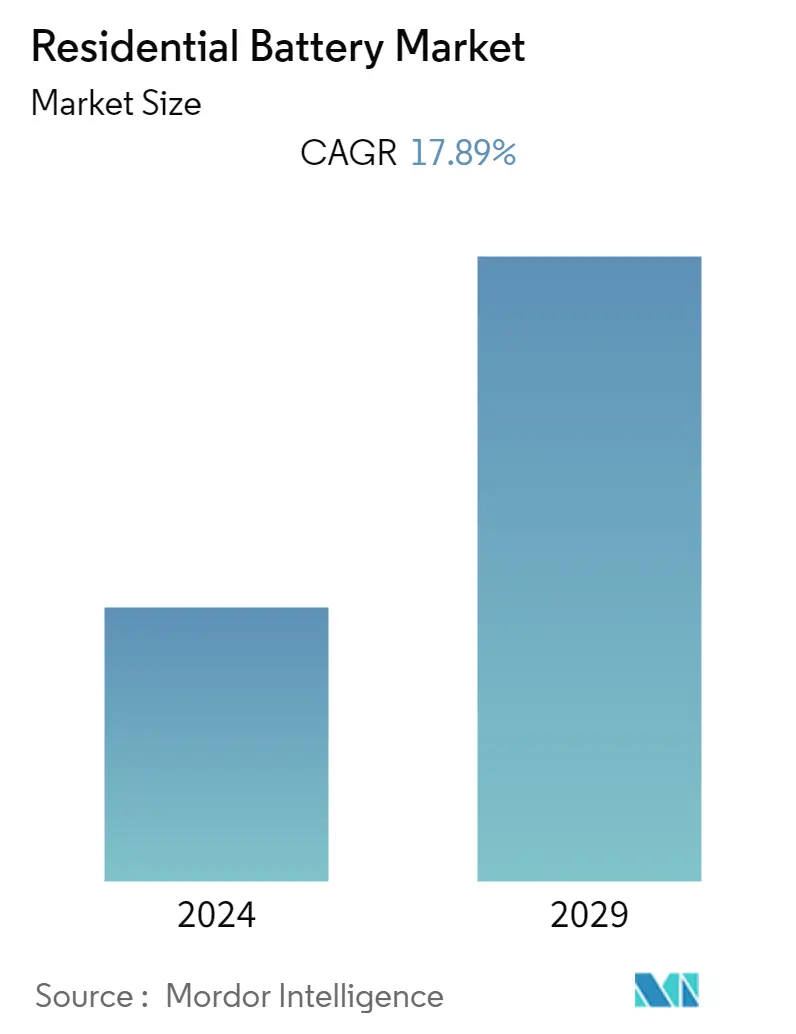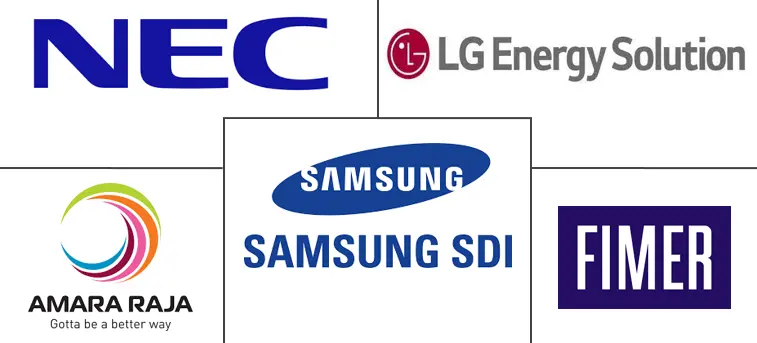Market Size of Residential Battery Industry

| Study Period | 2021 - 2029 |
| Base Year For Estimation | 2023 |
| CAGR | 17.89 % |
| Fastest Growing Market | Asia Pacific |
| Largest Market | Asia Pacific |
| Market Concentration | Low |
Major Players
*Disclaimer: Major Players sorted in no particular order |
Residential Battery Market Analysis
The global residential battery market is expected to reach USD 13.01 billion by the end of the current year, and it is projected to register a CAGR of 17.89% during the forecast period.
Although the market studied was affected by COVID-19 in 2020, it recovered and reached pre-pandemic levels.
The declining prices of lithium-ion batteries are expected to drive the growth of the market studied during the forecast period. However, the environmental disadvantages of lead-acid batteries are expected to hamper the growth of the market studied during the forecast period. An increase in off-grid solar utilization is expected to create lucrative growth opportunities for the global residential battery market during the forecast period.
Asia-Pacific is dominating the market studied, and it is expected to witness the highest CAGR during the forecast period. This growth is attributed to the increasing investments and the adoption of residential rooftop solar installations in China, India, and Japan.
Residential Battery Industry Segmentation
The battery technologies considered in this report include lithium-ion, lead-acid, and other batteries (including nickel-cadmium, nickel metal hydride, zinc-carbon, and alkaline batteries) consumed across the global residential sector for different applications.
The residential battery market is segmented by type and by geography. By type, the market is segmented into lithium-ion batteries, lead-acid batteries, and other types. The report also covers the market size and forecasts for the residential battery market across major regions. For each segment, the market sizing and forecasts have been done based on revenue (USD billion).
| By Type | |
| Lithium-ion Battery | |
| Lead-acid Battery | |
| Others Types |
| By Geography | |
| North America | |
| Asia-Pacific | |
| Europe | |
| South America | |
| Middle East and Africa |
Residential Battery Market Size Summary
The residential battery market is experiencing significant growth, driven by the increasing adoption of renewable energy sources and the declining costs of lithium-ion batteries. These batteries are preferred over traditional lead-acid batteries due to their superior performance, longer lifespan, and reduced maintenance requirements. The market is witnessing a surge in demand for energy storage systems, particularly in regions with high solar rooftop installations. The Asia-Pacific region, led by countries like China and India, is dominating the market, supported by government policies and investments in solar energy infrastructure. The growth in this region is further bolstered by the rapid urbanization and the need for reliable power supply solutions.
The market landscape is characterized by a mix of established players and emerging companies, all vying for a share in the expanding market. Innovations in battery technology, such as the development of lithium iron phosphate batteries, are enhancing the appeal of residential batteries for various applications, including backup power and consumer electronics. Government initiatives in countries like the United States and Germany are creating favorable conditions for market expansion, with policies aimed at boosting domestic battery manufacturing and encouraging the adoption of energy storage systems. As the demand for residential batteries continues to rise, the market is poised for substantial growth, with lithium-ion batteries expected to maintain their dominance due to their cost-effectiveness and efficiency.
Residential Battery Market Size - Table of Contents
-
1. MARKET OVERVIEW
-
1.1 Introduction
-
1.2 Market Size and Demand Forecast in USD billion, till 2027
-
1.3 Recent Trends and Developments
-
1.4 Government Policies and Regulations
-
1.5 Market Dynamics
-
1.5.1 Drivers
-
1.5.2 Restraints
-
-
1.6 Supply Chain Analysis
-
1.7 Porter's Five Forces Analysis
-
1.7.1 Bargaining Power of Suppliers
-
1.7.2 Bargaining Power of Consumers
-
1.7.3 Threat of New Entrants
-
1.7.4 Threat of Substitutes Products and Services
-
1.7.5 Intensity of Competitive Rivalry
-
-
-
2. MARKET SEGMENTATION
-
2.1 By Type
-
2.1.1 Lithium-ion Battery
-
2.1.2 Lead-acid Battery
-
2.1.3 Others Types
-
-
2.2 By Geography
-
2.2.1 North America
-
2.2.2 Asia-Pacific
-
2.2.3 Europe
-
2.2.4 South America
-
2.2.5 Middle East and Africa
-
-
Residential Battery Market Size FAQs
What is the current Residential Battery Market size?
The Residential Battery Market is projected to register a CAGR of 17.89% during the forecast period (2024-2029)
Who are the key players in Residential Battery Market?
Amara Raja Batteries Ltd , LG Energy Solution, Ltd., FIMER SpA, Samsung SDI Co., Ltd. and NEC Corporation are the major companies operating in the Residential Battery Market.

